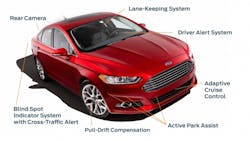Imagine a day when you're driving in a patch of heavy traffic and your car-sensing your elevated stress level-automatically blocks all incoming cell-phone calls until the congestion dissipates.
Ford Motor Co. (IW 500/6) does.
The automaker sees the ever-increasing number of sensors, cameras and data-capture technologies making their way into cars and trucks as the foundation for a future in which intelligent vehicles take an active role in preventing traffic accidents.
"Vehicle-control inputs, sensors, road conditions and biometric information such as a driver's pulse and breathing can all be used to create a driver-workload estimation that can then help manage certain functions in demanding situations," says Jeff Greenberg, senior technical leader of Ford Research and Innovation.
That includes "intelligently managing incoming communications" by analyzing data from driver-assist systems such as blind-spot radar sensors and lane-keeping cameras -- both of which are available on the 2013 Ford Focus -- to determine the level of external demand on a driver at any given time, Ford says.
The data -- along with input from the driver's use of the throttle, brakes and steering wheel -- is plugged into an algorithm that produces a "driver-workload estimator," which could block incoming phone calls if the workload is high.
For example, a vehicle's side-looking blind-spot radar sensors and forward-looking lane-keeping camera could indicate that the lane into which a driver is merging contains heavy traffic.
Combined with the vehicle's awareness of the fact that the driver has increased throttle-pedal pressure to speed up, the vehicle could determine that that the driver workload is too high for incoming phone calls.
Biometric Seat
In the future, Ford hopes to feed even more data into the driver-workload algorithm.
The automaker is developing a biometric seat, seat belt and steering wheel that can monitor the driver's condition and, consequently, create a more precise picture of the workload on the driver.
Ford's researchers have built a biometric seating buck to test a number of different sensors and gather data on how drivers respond to a variety of inputs for a driver-behavior model.
The experimental system adds several sensors to the steering-wheel rim and spokes to get more detailed driver information.
Ford notes that the technology is similar to the heart-rate sensors found on treadmills and other exercise equipment today.
Meanwhile, infrared sensors on the steering wheel monitor the palms of a driver's hands as well as his or her face, looking for changes in temperature.
A downward-looking infrared sensor under the steering column measures the cabin temperature to provide a baseline for comparing changes in the driver's temperature. The final sensor is embedded in the seat belt to assess the driver's breathing rate.
"While these features are still in research, they show significant opportunity for us to leverage data already being captured by the vehicle and apply an intelligent decision-making system to simplify the driving experience," says Gary Strumolo, manager of vehicle design and infotronics, Ford Research and Innovation.
"Biometric or health information of the driver can help us better tailor the experience when behind the wheel."
About the Author
Josh Cable
Former Senior Editor
Former Senior Editor Josh Cable covered innovation issues -- including trends and best practices in R&D, process improvement and product development. He also reported on the best practices of the most successful companies and executives in the world of transportation manufacturing, which encompasses the aerospace, automotive, rail and shipbuilding sectors.
Josh also led the IndustryWeek Manufacturing Hall of Fame, IW’s annual tribute to the most influential executives and thought leaders in U.S. manufacturing history.
Before joining IndustryWeek, Josh was the editor-in-chief of Penton Media’s Government Product News and Government Procurement. He also was an award-winning beat reporter for several small newspapers in Northeast Ohio.
Josh received his BFA in creative writing from Bowling Green University, and continued his professional development through course-work at Ohio University and Cuyahoga Community College.
A lifelong resident of the Buckeye State, Josh currently lives in the Tremont neighborhood of Cleveland. When the weather cooperates, you’ll find him riding his bike to work, exercising his green thumb in the backyard or playing ultimate Frisbee.
